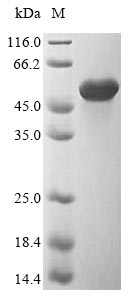The Recombinant uncultured bacterium Flagellin is expressed in E. coli and spans the full length of 1-459 amino acids. This tag-free preparation ensures a native protein conformation, with a purity of greater than 85% as confirmed by SDS-PAGE analysis. This high-quality reagent appears to be specifically designed for research applications requiring precise protein characterization and study.
Flagellin is a structural protein that forms the filament of bacterial flagella. It plays what seems to be a crucial role in bacterial motility, enabling movement through liquid environments. Beyond this mechanical function, flagellin is recognized by the immune system as a pathogen-associated molecular pattern (PAMP), which makes it a significant focus in studies related to microbial pathogenesis and host-pathogen interactions.
Potential Applications
Note: The applications listed below are based on what we know about this protein's biological functions, published research, and experience from experts in the field. However, we haven't fully tested all of these applications ourselves yet. We'd recommend running some preliminary tests first to make sure they work for your specific research goals.
Flagellin is a bacterial protein that forms the filament of flagella and requires precise folding, proper D0 domain formation, and specific polymerization for its functional activity in TLR5 recognition and flagellar assembly. The E. coli expression system is homologous to this bacterial protein, which increases the probability of correct folding. However, the large N-terminal 6xHis-SUMO tag (∼15 kDa) may sterically interfere with the protein's TLR5-binding domains and polymerization interfaces. While the full-length protein (1-193aa) contains all functional domains, the probability of correct folding with functional TLR5-binding and polymerization activity requires experimental validation.
1. Bacterial Flagellin Structure-Function Studies
This application carries a significant risk without structural validation. Flagellin's polymerization and TLR5 binding require precise tertiary structure. If correctly folded (verified through polymerization assays or structural analysis), the protein may be suitable for structural studies. If misfolded/unverified, structural data will not reflect native flagellin properties. The SUMO tag may interfere with polymerization and structural integrity.
2. Innate Immune Response Research
This application requires functional validation. TLR5 recognition depends on specific flagellin conformation and D0 domain accessibility. If correctly folded and active (verified through TLR5 activation assays), the protein may be suitable for immune studies. If misfolded/inactive (unverified), immune response assays will yield biologically meaningless results. The SUMO tag may block TLR5-binding sites.
3. Antibody Development and Immunological Assays
This application is highly suitable as antibody development relies on antigenic sequence recognition rather than functional protein folding. The full-length protein provides comprehensive epitope coverage for generating flagellin-specific antibodies. The high purity (>90%) ensures minimal contamination-related issues during immunization protocols.
4. Protein-Protein Interaction Studies
This application carries a significant risk without proper folding validation. Flagellin interactions with TLR5 or other flagellar components require precise tertiary structure. If correctly folded (verified), the protein may identify physiological interaction partners. If misfolded/unverified, there is a high risk of non-specific binding or failure to replicate genuine interactions.
5. Comparative Microbiology and Evolution Studies
Meaningful comparative studies require native protein conformation and functional activity. If correctly folded and active (verified), the protein enables valid evolutionary comparisons of flagellin properties. If misfolded/inactive (unverified), comparative analyses would yield misleading evolutionary insights.
Final Recommendation & Action Plan
The E. coli expression system with a large SUMO tag poses challenges for producing a functionally active flagellin due to potential steric interference with TLR5-binding and polymerization domains. Begin with structural and functional validation using polymerization assays and TLR5 activation tests before considering Applications 1, 2, 4, and 5. Application 3 (antibody development) can proceed immediately. For reliable flagellin research requiring native functionality, consider tag removal or use tag-free constructs to minimize interference with critical functional domains.






